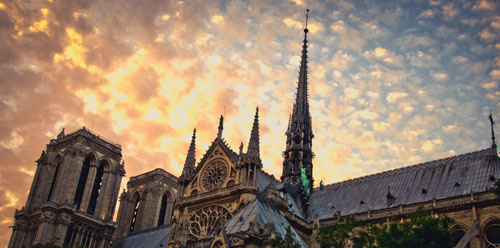Analysis by WorldTribune Staff, April 18, 2019
In the wake of the potential loss of Notre Dame Cathedral to fire, The New York Times published an article by Pamela Druckerman stating “we’ve failed, as a civilization, to be the caretakers of something priceless.”
“Priceless? Where in the New York Times over the past ten years has anything designed and built by men born of ‘white privilege’ been regarded as intrinsically valuable?” columnist Michael James wrote for American Thinker on April 17. “Excuse me if I don’t recall the Times giving one hoot about the moral concepts upon which Notre Dame was built.”

Druckerman says in the Times piece, “Urbane, intellectual Parisians often dismiss religion as archaic and unenlightened.”
The “pretentious and urbane liberals who dismiss religion as unenlightened,” James wrote, are “impatient and busy, seeing to it that everything must change to their liking, over the course of their lifetime, they have not cared one whit for a faith and a church that, only today, they call ‘priceless.’ ”
Perhaps Notre Dame “was designed to let a man know how small he is while conveying the greatness of our shared possibility,” James wrote. “That may sound too ‘Western Civ’ to readers and authors at the Times – after all, these people are not famous for their sense of intellectual modesty.”
Druckerman wrote: “It’s partly that, at 856 years old, Notre-Dame has witnessed much of French history. It’s where Henry VI was crowned, and Napoleon became emperor.”
“Oh my, infamous dead heterosexual cisgendered males once made history there; the Times should use current media vernacular when bemoaning the physical demise of a structure that represented an institution they abhor solely upon their own dichotic moral grounds,” James wrote.
In the Times piece, Druckerman wrote: “Residents might not have fully realized it until Monday, but I think it reassured them to know that at the heart of their highly planned city was someplace entirely non-rational and non-Cartesian.”
Catholicism “is labeled non-rational, as if the current liberal craze for gender-neutral public facilities represents a modern approach to completely rational thought,” James wrote.
Druckerman also wrote: “Notre-Dame’s hulking, Gothic presence has long suggested that there is something mysterious and unknowable at the center of it all.”
James wrote: “It might be too late for urbane and rational liberals to ponder big questions like the possibility that there is something bigger than mankind, the New York Times, and Planned Parenthood behind the gift of life.”
French President Emmanuel Macron called the human effect of the fire a “tremblement intérieur” – an internal trembling. Druckerman says, “There’s also a shared sadness and disappointment that, with the extensive damage, we’ve failed, as a civilization, to be the caretakers of something priceless.”
James wrote: “No, Ms. Druckerman, the something priceless was never made of wood and stone and glass. The physical structure only represented eternal values such as hope, faith, humility, and shared morality.
“Those are the priceless somethings that you, the New York Times, and the ‘urbane’ amongst us extensively damaged and failed to protect.”
Your Intel Brief: Geostrategy-Direct __________ Fix The Media Now
